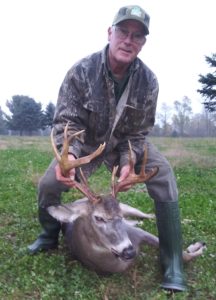Michigan Needs to Kill More Whitetail Does
By Glen Wunderlich
Hunters can learn plenty about deer-hunting trends by looking at the numbers compiled by various wildlife agencies across the states. Many Michiganders, however, seem bent on focusing on a particular segment of the whitetail population: bucks.
Back in the days of market hunting in the early to mid-1900s, deer herds were decimated by unregulated hunting. Therefore, it made sense to protect female deer to regenerate herds. Although those days are behind us, some of the thinking that prevailed then seems to be dominating too many of our hunters today. Trends were showing promising reversals in years subsequent to 1999, but we hunters have exhibited shortsightedness, once again.
In the current issue of Quality Whitetails published by the Quality Deer Management Association, its director of communication, Kip Adams portrays disturbing projections based on our DNR’s compilation of numbers in his piece, “The Dwindling Doe Harvest.” Specifically, year 2014 signaled the start of a significant slide in antlerless harvests reaching a low point in year 2016. That was the first year since 1999 that more antlered deer were taken than antlerless deer. If you think that’s a good thing, read on.
The American wildlife management model, that has been successful in restoring not only whitetail deer herds but that of elk, antelope, and wild turkeys to name a few, depends largely upon hunter participation. Hunters fork over hard-earned dollars to participate in hunting activities, play by the states’ management-plan rules, and reap the rewards for not only themselves but for non-hunters alike. Their license fees and excise taxes on equipment is the primary source of revenue for management agencies across the nation.
As Kip Adams points out, hunting is an essential tool for sound deer management and part of our sporting heritage. However, in most states hunter numbers have declined, and existing hunter recruitment programs are proving only marginally effective. Decreasing revenues follow.
From 2006 to 2011 hunter numbers increased by over one million, but during the past five years we lost 2.2 million hunters nationally. In 2016 (the last year of available data), 11.5 million people 16 years of age and older went hunting (5 percent of total U.S. population), averaging 16 days afield each. Eighty percent of those 11.5 million hunters pursued big game like deer and elk.
Although Michigan has one of the top-5 states with the highest number of deer hunters, we have fewer deer and fewer hunters than in the past. Disturbingly, Michigan hunters shot about 3 bucks for every 2 antlerless deer. A closer look reveals we are shooting too many immature bucks – a whopping 47 percent of bucks taken are adolescents of 1 ½ years of age. At the same time, compared to the 5-year average, our antlerless harvest is down 15 percent.
If ever we want to avoid the needless expense of sharpshooters (hired guns) in common use today – or, worse yet to continue an even more expensive and insane sterilization approach – we need to wise up. If you’ve ever wondered why you see far more does than bucks, you have your answer.
Taking more antlerless deer will help to balance the ratio of male and female deer, thus improving the health of the herd and strengthening the habit that holds them.





